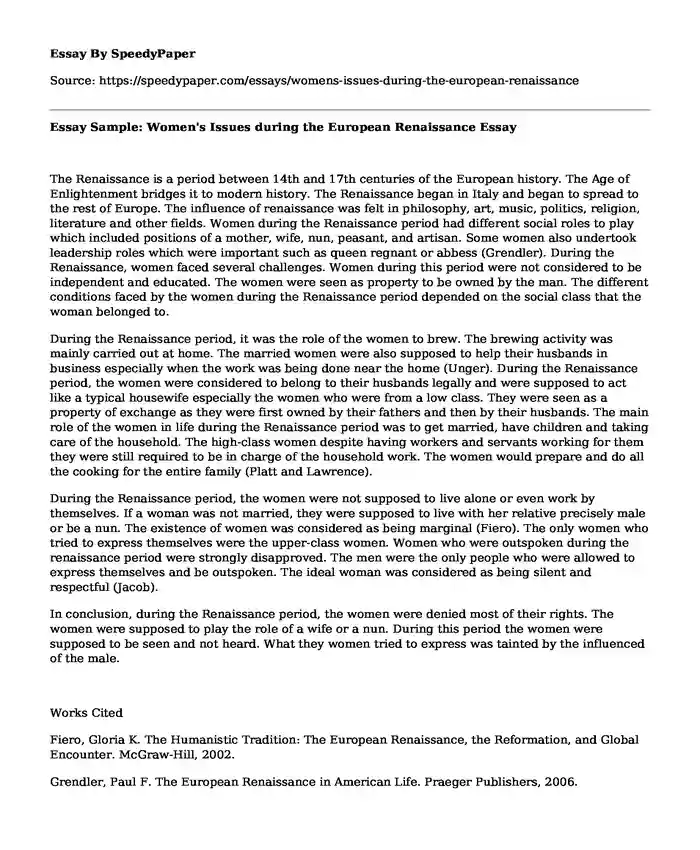The Renaissance is a period between 14th and 17th centuries of the European history. The Age of Enlightenment bridges it to modern history. The Renaissance began in Italy and began to spread to the rest of Europe. The influence of renaissance was felt in philosophy, art, music, politics, religion, literature and other fields. Women during the Renaissance period had different social roles to play which included positions of a mother, wife, nun, peasant, and artisan. Some women also undertook leadership roles which were important such as queen regnant or abbess (Grendler). During the Renaissance, women faced several challenges. Women during this period were not considered to be independent and educated. The women were seen as property to be owned by the man. The different conditions faced by the women during the Renaissance period depended on the social class that the woman belonged to.
During the Renaissance period, it was the role of the women to brew. The brewing activity was mainly carried out at home. The married women were also supposed to help their husbands in business especially when the work was being done near the home (Unger). During the Renaissance period, the women were considered to belong to their husbands legally and were supposed to act like a typical housewife especially the women who were from a low class. They were seen as a property of exchange as they were first owned by their fathers and then by their husbands. The main role of the women in life during the Renaissance period was to get married, have children and taking care of the household. The high-class women despite having workers and servants working for them they were still required to be in charge of the household work. The women would prepare and do all the cooking for the entire family (Platt and Lawrence).
During the Renaissance period, the women were not supposed to live alone or even work by themselves. If a woman was not married, they were supposed to live with her relative precisely male or be a nun. The existence of women was considered as being marginal (Fiero). The only women who tried to express themselves were the upper-class women. Women who were outspoken during the renaissance period were strongly disapproved. The men were the only people who were allowed to express themselves and be outspoken. The ideal woman was considered as being silent and respectful (Jacob).
In conclusion, during the Renaissance period, the women were denied most of their rights. The women were supposed to play the role of a wife or a nun. During this period the women were supposed to be seen and not heard. What they women tried to express was tainted by the influenced of the male.
Works Cited
Fiero, Gloria K. The Humanistic Tradition: The European Renaissance, the Reformation, and Global Encounter. McGraw-Hill, 2002.
Grendler, Paul F. The European Renaissance in American Life. Praeger Publishers, 2006.
Jacob, P L. Manners, Customs and Dress during the Middle Ages and Renaissance Period. 2014.
Platt, Richard, and David Lawrence. In the Renaissance. Sea-to-Sea Publications, 2011.
Unger, Richard W. Beer in the middle Ages and the Renaissance. U of Pennsylvania P, 2007.
Cite this page
Essay Sample: Women's Issues during the European Renaissance. (2022, Mar 15). Retrieved from https://speedypaper.net/essays/womens-issues-during-the-european-renaissance
Request Removal
If you are the original author of this essay and no longer wish to have it published on the SpeedyPaper website, please click below to request its removal:
- Do College Essays Serve Their Purpose? Free Essay
- Essay Example on Illegal Immigrants in California
- Journalism and Social Media, Essay Sample for Your High Grades
- Essay Sample on Creating a Research Strategy for Death and Consciousness Topic
- Mental Illness Stigma, Essay Example for Everyone
- Essay Sample: Introduction to Depression and Mental Health
- Paper Sample on Eugenics in America: Unraveling the Historical Impact on Race, Sex, and Disability
Popular categories





